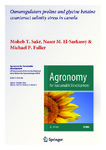Osmoregulators proline and glycine betaine counteract salinity stress in canola
| dc.contributor.author | Sakr, MT | |
| dc.contributor.author | El-Sarkassy, NM | |
| dc.contributor.author | Fuller, MP | |
| dc.date.accessioned | 2013-02-24T13:54:03Z | |
| dc.date.available | 2013-02-24T13:54:03Z | |
| dc.date.issued | 2012-07 | |
| dc.identifier.issn | 1774-0746 | |
| dc.identifier.issn | 1773-0155 | |
| dc.identifier.uri | http://hdl.handle.net/10026.1/1426 | |
| dc.description.abstract |
Salt inundation leads to increased salinization of arable land in many arid and semi-arid regions. Until genetic solutions are found farmers and growers must either abandon salt-affected fields or use agronomic treatments that alleviate salt stress symptoms. Here, field experiments were carried out to study the effect of the osmoregulators proline at 200 mg L-1 and glycine betaine at 400 mg L-1 in counteracting the harmful effect of soil salinity stress on canola plants grown in Egypt. We assessed growth characteristics, yield and biochemical constituents. Results show first that all growth characters decreased with increasing salinity stress but applied osmoregulators alleviated these negative effects. Second, salinity stress decreased photosynthetic pigments, K and P contents, whilst increasing proline, soluble sugars, ascorbic acid, Na and Cl contents. Third, application of osmoregulators without salt stress increased photosynthetic pigments, proline, soluble sugars, N, K and P contents whilst decreasing Na and Cl contents. It is concluded that the exogenously applied osmoregulators glycine betaine and proline can fully or partially counteract the harmful effect of salinity stress on growth and yield of canola.© INRA and Springer-Verlag, France 2012. | |
| dc.format.extent | 747-754 | |
| dc.language | en | |
| dc.language.iso | en | |
| dc.publisher | Springer Science and Business Media LLC | |
| dc.subject | Salt stress | |
| dc.subject | Osmoregulators | |
| dc.subject | Canola | |
| dc.subject | Glycine betaine | |
| dc.subject | Proline | |
| dc.title | Osmoregulators proline and glycine betaine counteract salinity stress in canola | |
| dc.type | journal-article | |
| dc.type | Journal Article | |
| plymouth.author-url | https://www.webofscience.com/api/gateway?GWVersion=2&SrcApp=PARTNER_APP&SrcAuth=LinksAMR&KeyUT=WOS:000306061800014&DestLinkType=FullRecord&DestApp=ALL_WOS&UsrCustomerID=11bb513d99f797142bcfeffcc58ea008 | |
| plymouth.issue | 3 | |
| plymouth.volume | 32 | |
| plymouth.publication-status | Published | |
| plymouth.journal | Agronomy for Sustainable Development | |
| dc.identifier.doi | 10.1007/s13593-011-0076-3 | |
| plymouth.organisational-group | /Plymouth | |
| plymouth.organisational-group | /Plymouth/Faculty of Science and Engineering | |
| plymouth.organisational-group | /Plymouth/Faculty of Science and Engineering/School of Biological and Marine Sciences | |
| plymouth.organisational-group | /Plymouth/REF 2021 Researchers by UoA | |
| plymouth.organisational-group | /Plymouth/REF 2021 Researchers by UoA/UoA06 Agriculture, Veterinary and Food Science | |
| plymouth.organisational-group | /Plymouth/Users by role | |
| plymouth.organisational-group | /Plymouth/Users by role/Academics | |
| dc.identifier.eissn | 1773-0155 | |
| dc.rights.embargoperiod | Not known | |
| rioxxterms.versionofrecord | 10.1007/s13593-011-0076-3 | |
| rioxxterms.licenseref.uri | http://www.rioxx.net/licenses/all-rights-reserved | |
| rioxxterms.type | Journal Article/Review |


